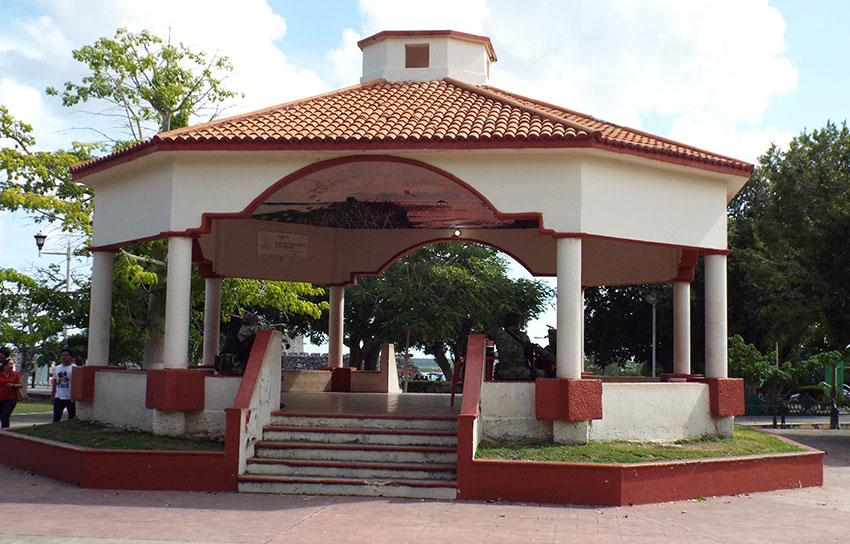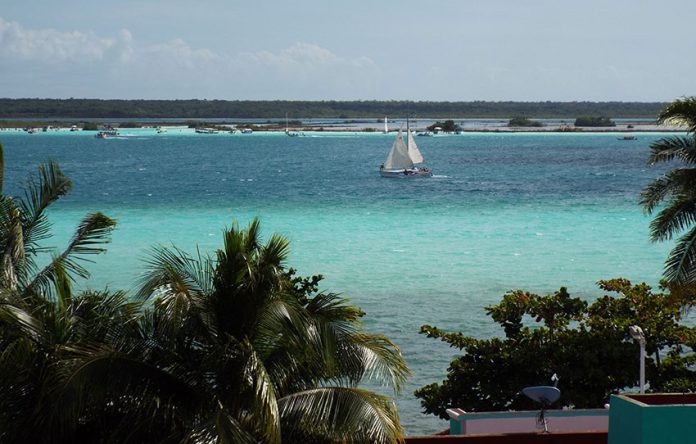There are places in Mexico that retain their charm yet swarm with tourists – think of the town of Sayulita on the west coast. Then there are places swarming with tourists that have become charmless – like the hotel zone in Cancún.
There are beautiful places where hardly anyone goes and places where, even if you wanted to stay, there isn’t anything in town that could house you.
And then there’s Bacalar – a place on the edge of a boom, with domestic tourists who’ve spent their childhoods vacationing there and foreigners who are just beginning to discover its shores.
At this point Bacalar — located on a finger lake of the same name just above the Belize border in Quintana Roo — is still so stunning that it feels you’ve stumbled upon some magical land. Unlike similar places in Mexico, its “lake of seven colors” is surprisingly quiet, the water breathtakingly clear and the prices incredibly modest. You can rent an entire house right on the water for US $100 a night (less in the off season) and head out to one of the local balnearios for a day of swimming and picnics for about $2.50.
But you can also get French press coffee at the darling Enamora Bacalar café or take a yoga class at Akalki Holistic Center. While a stay at MBH Maya Bacalar or Mia Bacalar runs over $200 a night, a backpackers’ hostel in town will get you just as close to the water for a fraction of the price.

While the lake is definitely the town’s biggest draw, nature tours, nearby Mayan ruins and a growing selection of restaurants and breweries can keep you pleasantly busy for more than a few days. Andrea Arroyo, owner of Hotel Valdre, is even planning a specialty coffee bar (in addition to her smoothie bar) – yet another sign that the town is on its way to being hip in every way.
But Bacalar has the feel of a promising child star. And those that love her find themselves asking, will the weight of fame create a reckless and wild youth, or can someone keep her grounded while she steals the show?
Bacalar has existed in near anonymity outside its region until the last decade or so when European travelers started to take an interest in its gorgeous lake and delicious weather. Nearby Chetumal is one of the youngest cities in Mexico and neither place has had the concerted investment of Cancún or Tulum to the north. Rapid growth in the last few years has not been matched by basic services and infrastructure needs.
“It’s too bad that everyone that has arrived in Bacalar wants to open a hotel,” says Arroyo, “when there are so many opportunities to create services.” This includes things like trash separation and processing, hospitals, and banks – all in shortage in Bacalar.
Structurally — and literally — there are a lot of holes. The roads outside of town that take you to the many lakeside hotels and rentals are in terrible shape, and to say the internet and cell signal is poor is putting it kindly. Taxis, with a chokehold on transportation — there are no public buses except long-haul ones to Chetumal and back — charge exorbitant amounts compared to prices nationally.
But the most pressing issue of all, as the town moves into the tourism spotlight, is Bacalar’s unique ecosystem and its preservation. Laguna Bacalar is just beginning to be studied by scientists but so far there have been upwards of 80 zooplankton species discovered that were previously unknown and the lake’s waters have some of the oldest organisms in the world – stromatolites, which are colonies of bacteria that form rock-like structures in the water. Thousands of migratory birds nest in the lake’s mangrove forest each year.

The Bacalar Department of Ecology started a campaign last May to inform business owners and visitors what they could do to help preserve the lake – no sunscreen, don’t collect the shells or creatures from the lake, use non-motorized transportation on the water – and conscientious hotel owners and locals are also doing their part, trying to reduce pollution in the lake and keep it beautiful for the next generation of admirers.
But many long-time residents are resistant to their efforts, questioning why all of a sudden the things they’ve always done are being condemned by the environmentally minded. Arroyo says that educating people about the lake’s fragility is an uphill battle. The chivita snail has long been eaten here and used in local crafts and jewelry. But studies show that they are not only vital to the life of the lake’s ecosystem but they also contain high levels of heavy metals that make them unfit for human consumption.
So there are a lot of changes happening in this tiny southern stretch of Mexico’s Yucatán peninsula, and a lot of work yet to do, but that doesn’t mean outsiders should stay away. Tourists can have a positive impact on the growth of this area if they travel right.
How then can visitors help in the conservation effort? According to Arroyo there are plenty of eco-friendly activities on the lake.
“Sailboats don’t create any pollution in the water,” she says, “and there are paddle-boat tours, kayaks. There are ways to enjoy the lake without destroying it.”
It’s also important to stay away from protected areas like the lake’s mangrove forest and places where the stromatolites are peeking out from under the water. These creatures are so fragile that a brush against them can kill decades of growth in a single stroke. Tourists can also ask their hotels if they provide biodegradable shampoos and soaps, or bring their own along. It’s best not to wear sunscreen or any other creams in the water but if you must, make sure they are biodegradable. Be conscientious about single-use plastics and avoid generating waste whenever you can.
Choose hotels that are working to make Bacalar a more eco-friendly place. We all have a small part to play in keeping this little paradise beautiful for the next generation of travelers.
The writer is a regular contributor to Mexico News Daily and lives in Mexico City.
